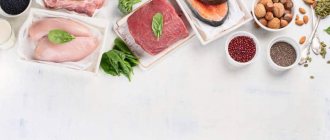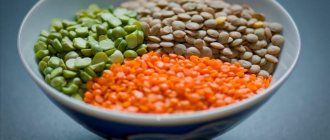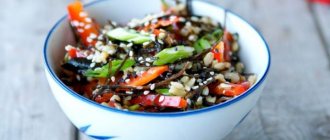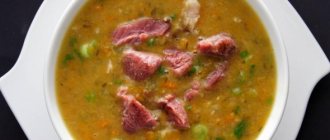Hummus is a snack that is more popular in Israel, Turkey, Jordan and Cyprus. A paste-like mixture of chickpeas, sesame seeds and various spices makes it dietary and extremely beneficial for our body. Hummus is usually eaten with pita bread, pita bread and vegetables during main meals, and is also ideal for snacking throughout the day.
Unsplash
This “protein bomb” is not only spicy, but also extremely healthy. Therefore, if you care about your health and lead an active lifestyle, such a dish will only further fill your body with vitamins and nutrients.
Read also:
Hummus according to an old recipe
How to choose fish for lunch
According to VTsIOM, only 7% of Russians buy chilled fish: the majority prefer fresh frozen.
And they do it right: the lion’s share of the product that lies on ice under the guise of being freshly caught is only defrosted fish at a higher price. But at the counter you have to decide not only about freshness, transparency of the eyes and the amount of icy glaze. The most difficult question is which fish to choose. The correct answer depends on your tastes, goals and culinary plans. Cod.
Winner in the "universal choice" category. Cod is equally good boiled, baked or fried, it has a neutral taste and goes well with a variety of foods, not too fatty, but not dry either - in general, the best option for those who don’t want to think twice about it.
Mackerel.
Nutritionists are more likely to criticize smoked mackerel, which is familiar to most: the product contains too much salt. Another thing is frozen mackerel. Fatty enough to saturate the body with valuable Omega-3 acids and satisfy hunger. Important advantages of mackerel are that it is always a wild product and not aquaculture. It is not recommended to fry this fish - the smell in the process will be specific (although there are fans of it).
Salmon.
According to tradition, many types of red fish in the Russian mind are united under the word “salmon”, and this is a really close company: here are trout, salmon, coho salmon, sockeye salmon and pink salmon. All these types differ in the percentage of fat content, taste and texture, and are similar in their balanced composition of nutrients and interesting taste. The main trump cards of red fish are the high content of Omega-3 and vitamin D. Together they increase the chances of losing weight for those who need it, and give everyone else a boost of energy, improve metabolism and skin quality. Another bonus is that red fish is delicious to eat even raw, like tartare or stroganina.
Catfish.
The spotted predator looks so unfriendly that many do not risk taking it home. It is difficult to cook catfish so that it is juicy and does not fall apart in the pan. But by following simple rules, you can solve this difficult problem. First, it is especially important to defrost catfish at refrigerator temperature rather than in the room. Secondly, before cooking it needs to be soaked in a saline solution. Thirdly, it is better to slightly undercook this fish rather than overcook it. A batter made from flour and eggs will always help here: if you fry catfish in such a “shell”, the fat is more likely to be sealed inside the piece, and the flesh itself will not disintegrate into fibers.
Haddock.
Those who remember Soviet times hate haddock. Alas, in the era of empty shelves, this fish from the cod family was often alone responsible for the assortment of the entire fish department. Add to this imperfect refrigeration equipment, in which the fish was defrosted and frozen again, and we get a questionable taste and texture. Fortunately, in the 21st century, haddock is preparing to regain its good name and reputation. Its noble white meat has already been appreciated by Scandinavian chefs who set fashion around the world. If you want to be on trend, cook haddock under marinade, bake with vegetables and herbs, fry in flour the old fashioned way, and you will be pleasantly surprised by the result.
Halibut.
A distant relative of flounder and turbot, halibut is rated among professional chefs for its delicate and neutral taste. This means that you can fantasize with it as you please: combine it with different spices and sauces, experiment with serving. It is especially valuable that halibut does not like long heat treatment: it needs to be baked or fried quickly so as not to lose its juiciness.
Description of the dish
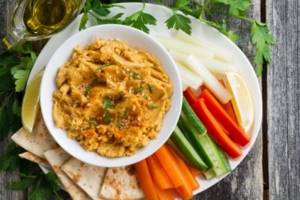
The recipe for this dish was known 8 centuries ago in the Ottoman Empire, as well as in a number of eastern countries - Jordan, Syria, Libya, Greece. Today, hummus is increasingly included in the daily diet of people who prefer a healthy diet.
If we take the literal translation of the word “hummus,” it can mean both the lamb peas themselves (“nokhut”) and the mashed snack prepared from it. The protein contained in chickpeas is perfectly absorbed by the body.
Chickpeas are similar in structure to animal protein - an excellent alternative to fatty meat foods, which contain a lot of cholesterol.
In addition, traditional hummus includes :
- Sesame paste (tahini). It contains a high percentage of Ca, K, P and Mg. Omega-3 fatty acids in its composition increase skin firmness and elasticity and slow down the aging process.
- Olive oil . It has been known since ancient times for its healing properties: it has a beneficial effect on the digestive system, normalizes stomach acidity, and is used to treat nervous system disorders.
- Garlic . This component normalizes cholesterol levels and has antibacterial properties (suppresses the activity of staphylococci, diphtheria bacillus and yeast).
- Lemon juice . Lemon juice is a real storehouse of vitamins and nutrients, improves memory and concentration, and also strengthens the immune system, increasing the body's protective properties.
- Paprika . Stimulates the pancreas and liver, helps reduce stomach colic and flatulence. Contains calcium in large quantities, as well as fatty acids valuable for the body.
Hummus can be prepared not only from chickpeas, but also from beets, beans, and buckwheat.
Watch the video about the benefits and harms of chickpea hummus:
Compound
The benefits of hummus can be judged by its composition, which includes various ingredients. The exact information about its vitamin set varies, but there is a list of microelements and vitamins that are always present in it. The calorie content of this dish per 100 g varies from 160 to 300 kcal. As a rule, garlic, lemon juice, olive oil, and other ingredients with beneficial qualities are added to hummus.
The benefits of hummus are determined by the fact that it always contains amino acids, microelements, plant fiber, polyunsaturated acids, B vitamins, and folic acid.
Vegetable oils provide vitamins E and A, which dissolve in fat, and lemon contains vitamin C.
On average, 100 g of hummus contains:
- 110 mg phosphorus;
- 242 mg sodium;
- 173 mg potassium;
- 1.56 mg iron;
- 29 mg magnesium;
- 49 mg calcium;
- 0.0024 mg selenium;
- 1.09 mg zinc;
- 0.57 mg manganese;
- 0.22 mg copper.
Chickpea spread or low-calorie hummus
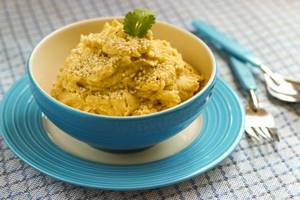
Hummus prepared according to the original recipe is quite high in calories, more than 440 kcal/100 g. With simple manipulations you can reduce its calorie content by 3.5 times and get a very tasty, low-calorie hummus.
Number of servings/weight: 5-8/800 g.
Cooking time: 50 min. – cook chickpeas, 15 minutes – rest
Difficulty: not difficult
- dry chickpeas – 250 gr.
- carrots – 1 pc.
- celery (greens) – 1 stalk
- lemon juice – 20 gr.
- water from cooking chickpeas – 250 gr.
- olive oil – 7 gr.
- sesame oil – 10 gr.
- salt, ground black pepper - to taste
- sesame (seeds) – 2 gr.
onion – 1/2 onion
Hummus in Siberia is a rare dish, little known. Its homeland is the hot Mediterranean, and it is based on boiled chickpea puree, generously flavored with a special sesame paste - tahini, olive oil and oriental spices. It would seem that replacing tahini with water left after boiling chickpeas would not lead to anything good, but this is not so! The pate turned out great, tasty, tender, and you can’t tear yourself away from it! And this is not even a pate, but a protein puree.
Very easy to prepare
- Soak the chickpeas overnight in plenty of water.
- In the morning, drain the water and rinse the beans well.
- Fill with fresh water, put on fire, bring to a boil, and drain
- Fill with fresh water again, put on fire, add carrots, onions and celery for flavor, after cutting them in half (do not chop them), add a little salt
- Boil until tender (the beans retain their shape, but are soft inside). This requires different times, from 40 minutes to 2 hours, which depends on the type of beans and the hardness of the water.
- Drain the water into a separate container (we will need it), throw out the onions, carrots, celery
- Place the beans in a blender bowl, add lemon juice, chickpea broth, olive and sesame oil, salt, pepper - beat until smooth and fluffy.

- If the blender bowl is small, then do the previous step in two steps
- If the beans are not whipping well due to dryness, add a little more chickpea broth
- If you want to make hummus more like the classic one, add ground cumin, coriander and fresh garlic.
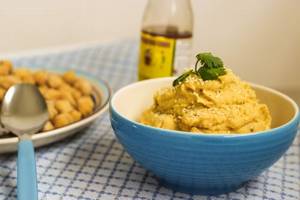
The result is a universal dish, full of vegetable protein, long-lasting satiation, and which is perfect for any meal: breakfast, lunch, dinner and snack.
ladycaloria.ru
What do you eat hummus with?
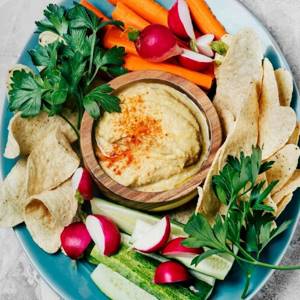
The versatility of the dish is an added advantage. Hummus is served as a cold appetizer or spread for sandwiches - in the Middle Eastern version, it is eaten with pita bread, unleavened and yeast flatbreads.
Neutral taste goes perfectly with many products:
- In Israel, hummus is served with chicken; in Turkey - with beef and lamb, cheese;
- Seafood is also an excellent “companion”, and this tandem is popular in the Middle East wherever it is possible to get fresh fish for the table;
- Vegetarians of all countries enjoy hummus with vegetable sides, and in this case the list can be long;
- In Arabic cuisine, hummus is eaten with hummus: falafel made from chickpea puree is an addition to the dish;
- Chickpea puree can be a dessert if you complement it with sweet ingredients, cocoa, fruits, and traditional flavors that are used for confectionery and baked goods.
There are no contraindications for experiments and new culinary discoveries, but you need to take into account the advice of modern nutritionists, and the national cuisines of the peoples of the Middle East and Asia will be a good basis for the original hummus recipe.
Calorie content of hummus KBJU
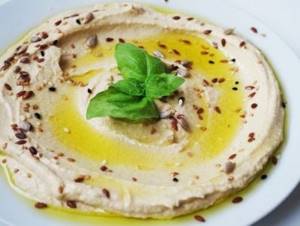
If hummus is prepared according to the classic recipe, then here is its approximate nutritional value. Calorie content (per 100 grams) – 220-260 Kcal.
Squirrels – 9%.
Fats – 14-17%.
Carbohydrates – 16-18%.
Hummus perfectly satisfies the appetite, but does not have a harmful effect on the body and does not harm the figure. The high calorie content of the dish is achieved due to the olive oil it contains, but it has enormous nutritional value for the body.
Vegetarians can also safely eat this dish.
Chickpeas contain fiber , which perfectly saturates, while regulating blood sugar levels, which is important for diabetics and patients with hyperglycemia.
Find out what you eat hummus with here; and how to cook bulgur soup - here.
What does it taste like?
What hummus tastes like is not an idle question. Nobody wants to buy pasta and keep it in the refrigerator “just in case.” If hummus is without additives, its taste is neutral, closer to sweetish - like boiled chickpeas, but with a bright nutty flavor.
In addition to sweetness, you can feel a slight sourness from lemon juice. Garlic, if it is present in the composition (which is not always the case), adds piquancy. And the flavor spectrum is completed by a delicate creamy aftertaste, which comes from crushed sesame seeds.
When adding spices and herbs, the shades of taste can change and become even more expressive and bright.
Hummus - benefits and harm
Speaking about the harm and benefits of hummus, first of all you should learn more about this product and its preparation.
It has a paste-like consistency that can be used in food, as a spread on a sandwich, sauce or snack. Hummus has its beneficial properties thanks to the use of Turkish nuts and sesame paste as the main ingredients. To complement the dish, various seasonings are used, olive oil, pine nuts, garlic, paprika, hot pepper, etc. Let's learn about the dangers and benefits of hummus for the figure and the human body as a whole.
What are the benefits of hummus?
The benefits of hummus for women are determined by the properties of those products that are additionally included in its composition. The first thing that hummus is good for women is its high nutritional value, because even a small portion will quickly saturate the body. It is recommended to start your meal with hummus, this is necessary in order to avoid overeating in the future, since the high fiber content in the product allows you to quickly give a feeling of fullness.
This dish will be especially useful for vegetarians, as it contains a large amount of iron and protein.
The benefit of hummus lies in the fact that it contains a large number of useful components. Here is just a partial list of what is included in this dish:
- Polyunsaturated essential fatty acids - they are necessary for removing cholesterol from the body, helping to reduce body weight and lower blood pressure.
- B vitamins (B5, B4, B1) – normalize blood sugar levels, support the genetic process in cells, help improve brain function, and are needed for the endocrine and cardiovascular systems.
- The presence of folic acid is required for bone marrow function, protein biosynthesis, immune support, and the absorption of B vitamins.
- Plant fiber.
- Microelements (molybdenum, manganese, iron).
- Amino acid tryptophan (takes part in the synthesis of serotonin, the “happiness hormone”).
In addition, hummus contains sesame (contains calcium in large quantities) and olive (a source of vitamin E) oils, lemon juice (vitamin C). As can be judged from all of the above, hummus can essentially be considered an extremely healthy product. It can be prepared at home or purchased ready-made. Hummus will be very tasty when combined with pita bread or pita bread.
Like many other dishes, hummus has contraindications that anyone who decides to try this delicious dish should be aware of. It has been proven that consumption of hummus can cause flatulence, so it is extremely undesirable to get carried away with such a product, especially if there is a tendency to excessive formation of gases. In addition, people who tend to be overweight should not indulge in such a dish. Uncontrolled consumption of this product can cause metabolic disorders, which in the future can cause excess weight.
To summarize, it should be said that you can and should consume hummus, but in reasonable quantities. In addition to the above warnings, hummus is a healthy and tasty dish containing a large amount of vitamins and beneficial microelements that are so important for our body.
How to eat hummus to lose weight
Hummus should be used as a dip for vegetables such as red pepper slices, cucumbers, green beans or carrots.
Hummus and vegetables (even carrots) are a good alternative to French fries. You should eat it as an afternoon snack or bring it as a snack to events to have something healthy.
As a salad dressing
Traditional salad dressings typically contain added sugar and calories, which largely negate the benefits of eating salad. Is hummus good for weight loss? Yes!

The benefits of hummus for the body
Below are eight scientifically proven health benefits of hummus.
Hummus is a very nutritious food rich in protein.
It is very beneficial to include hummus in your diet, as it contains a large amount of vitamins and minerals.
A 100 gram serving of hummus contains:
Calories : 166 kcal Fats : 9.6 g. Proteins : 7.9 g. Carbohydrates : 14.3 g. Fiber : 6 gr. Manganese : 39% DV Copper : 26% DV Folate : 21% DV Magnesium : 18% DV Phosphorus : 14 % DV Zinc : 12% DV Thiamine : 12% DV Vitamin B6 : 10% DV Potassium : 7% DV
Hummus is an excellent source of plant-based protein, providing 7.9 grams per serving. This makes it an excellent protein product for vegetarians. Consuming adequate protein is essential for optimal growth, recovery, and immune function.
In addition, hummus is an excellent source of iron, folic acid, phosphorus and vitamin B, which are important for vegetarians and vegans as they may not get enough from their diet.
Hummus contains a wide range of vitamins and minerals. It is also an excellent plant-based source of protein, making this product a nutritious option for vegans and vegetarians.
Hummus is rich in anti-inflammatory ingredients
Inflammation is the body's way of protecting itself from infection, disease, or injury. However, sometimes inflammation can persist longer than necessary.
This process is called chronic inflammation, and it is associated with many serious health problems.
Hummus contains healthy ingredients that can help fight chronic inflammation.
Olive oil is one of them. It is rich in powerful antioxidants that have anti-inflammatory properties. In particular, olive oil contains the antioxidant oleocanthal, which is believed to have similar anti-inflammatory properties to common anti-inflammatory drugs (1).
Likewise, the sesame seeds in tahini may help reduce inflammatory markers in the body, such as IL-6 and CRP, which are elevated in inflammatory diseases such as arthritis (2).
Moreover, many studies have shown that consuming a diet rich in legumes, such as chickpeas, reduces markers of inflammation in the blood (3).
Hummus contains chickpeas, olive oil and sesame seeds (tahini), which have been shown to have anti-inflammatory properties.
Hummus is rich in fiber, which promotes good digestion and gut health.
Hummus is an excellent source of dietary fiber, which can improve digestion.
Hummus contains 6 grams of plant-based dietary fiber per 100 grams, which is 24% of the daily fiber recommendation for women and 16% for men (4). Due to its high fiber content, hummus helps regular bowel movements. This is because plant fibers help soften and add bulk to the stool so it can more easily pass through the intestines.
What's more, soluble fiber, or prebiotics, also helps feed healthy bacteria that live in the gut and help digest food. One study found that adding 200 g. chickpeas (or other chickpea products) added to the diet for three weeks promoted the growth of beneficial bacteria, such as Bifidobacterium species, while inhibiting the growth of harmful bacteria (5).
The fiber in hummus is primarily converted by gut bacteria into the short-chain fatty acid butyrate. This fatty acid helps nourish colon cells and has many impressive benefits. Laboratory studies have shown that producing butyrate is associated with a lower risk of colon cancer and other health problems (6).
Hummus is an excellent source of fiber, which is beneficial for healthy gut function. In addition, dietary fiber can promote the growth of healthy gut bacteria, which convert fiber into butyrate, a type of fatty acid that helps nourish cells in the intestines.
Hummus has a low glycemic index, so it may help control blood sugar levels.
Hummus has several properties that can help control blood sugar levels.
First, hummus is made primarily from chickpeas, which have a low glycemic index (GI). The glycemic index is a scale that measures the ability of foods to raise blood sugar levels. Foods with a high GI value are quickly digested and then absorbed, causing blood sugar levels to spike and crash. Conversely, foods with a low GI value are slowly digested and then absorbed, resulting in slower and more balanced growth and lower blood sugar levels.
Hummus is also an excellent source of soluble fiber and healthy fats. Soluble fiber mixes with water in the intestines to create a gel-like substance. This can prevent blood sugar spikes by slowing the delivery of sugar into the bloodstream. Fats also help slow the absorption of carbohydrates from the intestines, which in turn allows for a slower, more consistent release of sugar into the bloodstream. A study found that white bread released four times more blood sugar after eating than hummus, despite containing the same amount of carbohydrates (7).
Hummus has a low glycemic index, which means it releases sugar slowly into the bloodstream. This is also facilitated by soluble fiber and the fat it contains.
Hummus is good for heart health
Cardiovascular diseases cause one in four deaths worldwide (8). Hummus contains several ingredients that may help reduce risk factors for heart disease.
Dietary hummus recipe. Calorie, chemical composition and nutritional value.
Soak the peas for 8-12 hours, cook until tender. Grind sesame seeds and cumin. Mix the peas with the resulting sesame paste and lemon juice in a blender, add spices: salt, cardamom, garlic
The energy value of dietary hummus is 297 kcal.
** This table shows the average levels of vitamins and minerals for an adult. If you want to know the norms taking into account your gender, age and other factors, then use the “My Healthy Diet” application.
Primary Source: Created in the application by the user.
Subtleties of cooking technology
Hummus is easy to prepare and can be stored in a sealed glass container in the refrigerator for up to 5 days. However, in order for the dish to turn out tasty and have the right consistency, you should know a few points.
- An important component of hummus is tahini. If it is excluded from the composition, the dish will lose the nutty notes that make its taste unique. If you couldn’t buy sesame paste, you can make it yourself at home. For this you will need sesame seeds and olive oil. Sesame seeds are fried in a dry frying pan, then crushed in a coffee grinder and ground with the addition of olive oil.
- Chickpeas take a long time to cook. The cooking time, if the chickpeas are not prepared in advance, can last for several hours. Pre-soaking the product for 10-12 hours allows you to reduce time costs. Then it will cook in 1-2 hours, on average in 1.5 hours.
- It is customary to regulate the thickness of bean paste using olive oil. However, if you are counting calories, it can be partially replaced with the broth in which the chickpeas were cooked.
- Traditional hummus recipes call for chickpeas as a base, but other legumes are almost adequate substitutes. It is customary to add spices to a dish based on your own taste. Additionally, the dish can be supplemented with herbs, vegetables, and mushrooms. The latter are often not mixed with other components, but are laid out on top of the paste.
Serve the hummus on a large shallow dish, making a well in the center and filling the well with olive oil. Boiled chickpeas or other products are sometimes placed in it. They can even be boiled or fried mushrooms, cut into small pieces. Pita or pita bread is served separately. Sometimes they are replaced with chips, which does not correspond to the spirit of healthy eating. It is better to replace pita, if necessary, with crispy bread.


